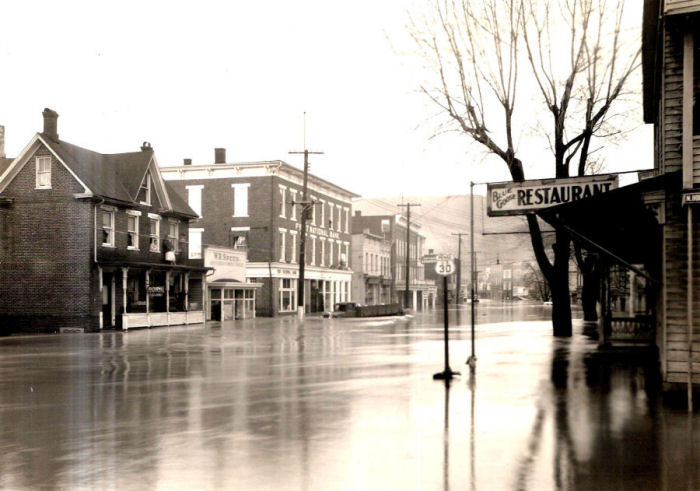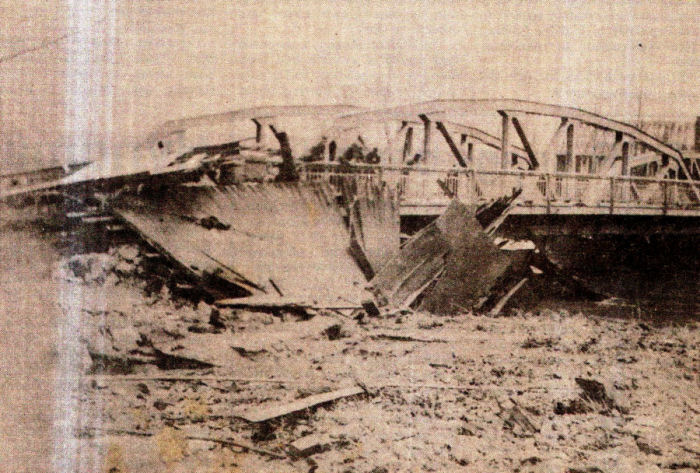


![]() By the 15th and 16th of March 1936, heavy snowfalls had left the land covered with a thick blanket of white. Then it began to rain. Within a 24-hour period the region received two inches of precipitation. By the 17th, St. Patricks Day, the small streams that fed the two largest waterways in the county (i.e. Dunnings Creek and the Raystown Branch of the Juniata River) had dumped a dangerously large amount of water. The entire county was hit hard, but the borough of Everett was hit the hardest; at least that borough bordering on the Juniata River sustained the costliest damages. Nearly $500,000 in damages was a very large sum in the 1930s, in a nation pulling itself out of the worst financial disaster, the Wall Street crash of 1929, to that point. According to the website 'TodaysMoney', $500,000 in 1936 would be the equivalent of $9,310,652 today!
By the 15th and 16th of March 1936, heavy snowfalls had left the land covered with a thick blanket of white. Then it began to rain. Within a 24-hour period the region received two inches of precipitation. By the 17th, St. Patricks Day, the small streams that fed the two largest waterways in the county (i.e. Dunnings Creek and the Raystown Branch of the Juniata River) had dumped a dangerously large amount of water. The entire county was hit hard, but the borough of Everett was hit the hardest; at least that borough bordering on the Juniata River sustained the costliest damages. Nearly $500,000 in damages was a very large sum in the 1930s, in a nation pulling itself out of the worst financial disaster, the Wall Street crash of 1929, to that point. According to the website 'TodaysMoney', $500,000 in 1936 would be the equivalent of $9,310,652 today!
![]() As the spring of 1936 began, there were two bridges that connected the borough of Everett on the north side of the river with the town of Earlston on the south side. Upstream, to the west end of Everett, was an old wooden bridge. Near the east end was a newer iron bridge. The rising waters pushing relentlessly against the old wooden bridge eventually smashed it off its foundation. The remnants flowed downstream, hit the the iron bridge and began to dam up the river. The water, unable to continue its course down the established riverbed, flowed over the banks and quickly rose in the streets of downtown Everett. The level rose until the ground floors of every building were submerged.
As the spring of 1936 began, there were two bridges that connected the borough of Everett on the north side of the river with the town of Earlston on the south side. Upstream, to the west end of Everett, was an old wooden bridge. Near the east end was a newer iron bridge. The rising waters pushing relentlessly against the old wooden bridge eventually smashed it off its foundation. The remnants flowed downstream, hit the the iron bridge and began to dam up the river. The water, unable to continue its course down the established riverbed, flowed over the banks and quickly rose in the streets of downtown Everett. The level rose until the ground floors of every building were submerged.
![]() Despite the high cost in material damages, the town was spared great human cost. The only fatality (in fact throughout the entire county) was the Reverend A. Johnson. The pastor, at ninety years of age and an Everett resident, died of a heart attack.
Despite the high cost in material damages, the town was spared great human cost. The only fatality (in fact throughout the entire county) was the Reverend A. Johnson. The pastor, at ninety years of age and an Everett resident, died of a heart attack.



![]() The double photo below shows the bridge at the Juniata Crossing before the flood and then after. The bottom shot shows the only thing remaining is one of the brick support piles.
The double photo below shows the bridge at the Juniata Crossing before the flood and then after. The bottom shot shows the only thing remaining is one of the brick support piles.

